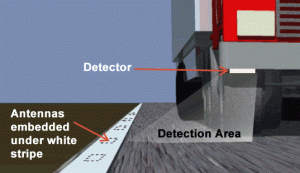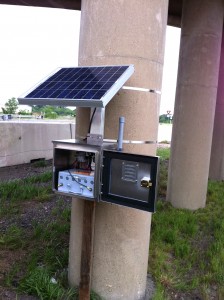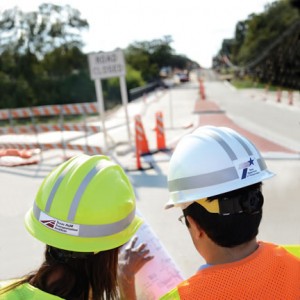TTI projects span the range of transportation research topics: from traditional areas, like highway safety and pavement design, to advanced vehicle information systems, multimodal integration, sustainable design and e-commerce. Where available, links to news stories and stories in the Texas Transportation Researcher, TTI’s flagship quarterly publication, are provided for each topic below.
Project Highlights
Connecting Vehicle to Infrastructure Research Partnership with UMTRI
TTI and the University of Michigan Transportation Research Institute (UMTRI) are collaborating on new research funded by the U.S. Department of Transportation that connects vehicles to infrastructure to benefit safety, mobility and the environment. Key collaborative areas include:
- Transportation data, analysis tools and national reports.
- Health/medical model for transportation safety.
- Freight movement.
Key objectives include:
- Establish a real-world, multimodal test site in Ann Arbor for enabling wireless communications among vehicles and roadside equipment to generate data for creating safety applications.
- Study passenger cars, motorcycles, commercial trucks, transit buses, and even bicycles equipped with a mix of integrated, retrofit and aftermarket vehicle-to-vehicle and vehicle-to-infrastructure based safety systems.
- Collaborate with UMTRI on new research plans for automated vehicles and their integrated electronic cyberphysical control systems.
Broadcast Traffic Signal Information to Vehicles
- Deploy signal phasing and timing (SPaT) proof of concepts with U.S. DOT for broadcasting traffic signal information to vehicles.
- Benefits: improved safety, eco-driving, optimized travel time (e.g., commercial, EMS drivers).

National Connected Vehicle Field Infrastructure Footprint Analysis
- Conduct research and analysis that forms the foundation for a national connected vehicle field infrastructure footprint for the American Association of State Highway Transportation Officials..
- Compile data, communications, and infrastructure needs.
- Create a set of generic deployment concepts.
- Solicit input from state and local agencies regarding deployment priorities to create a national connected vehicle field infrastructure footprint with considerations for deployment needs, costs, workforce and training requirements and challenges to implementation.
Improved Roadway Markings for Automated Vehicle Navigation
- Enhances lane departure detection in low-contrast conditions, heavy rain, and snow (supplementing current technologies, which fail).
- Connects a low-cost antenna embedded in the pavement marking to a low-power detector on the vehicle to provide wireless lane departure warning. | Profile of TTI’s Visibility Laboratory

Smart Work Zones – The I-35 Expansion Project
- TxDOT’s 96-mile, $2.5-billion expansion of I-35 in Central Texas.
- Created a first-of-its-kind traveler-information system that integrates Bluetooth® technology, Wavetronix sensors, and end-of-queue warning systems to forecast travel times to commuters, commercial drivers, and emergency personnel. | The I-35 Expansion Project
Using Bluetooth Technology to Aid in Hurricane Evacuation
- Travel-time monitoring system using Bluetooth technology.
- Provides traffic flow information on rural evacuation routes to aid decision-making during evacuations (e.g., contraflow).
Mobility
Congestion Monitoring

- Produces the annual national Urban Mobility Report. | Urban Mobility Information | The 2012 Urban Mobility Report
- Internationally recognized leader in congestion performance measure data analytics, particularly in the use of private sector car/truck speed data (e.g., INRIX). | TTI Teams with INRIX | Identifying Congested Corridors
- Recent research in mobile device location data for improved understanding of public transit, walking and biking.
Integrated Corridor Management — Dallas / Fort Worth
- Recommend area-wide transportation agency actions in response to incidents and congestion.
- Estimate future traffic conditions in real-time. | Interagency Cooperation, Integrated Corridor Management

Managed Lanes and Active Traffic Management
- National research leader (e.g., congestion pricing, active traffic management strategies).
- Partner with FHWA on multiple research initiatives including active transportation and demand management.
- Assist with managed lane development in Texas, California, Virginia, Minnesota, Washington State, Georgia, and other states. | International Active Traffic Management Research Benefits U.S.
Policy & Planning
Policy Implications of Automated Vehicles on Texas Highways
- Investigate and document the policy implications of automated vehicles on the Texas transportation system, notably in the areas of economic and societal impacts, infrastructure management, governance, issues of privacy and liability, and impacts on long-range transportation planning.
- Provide technical context in support of discussions regarding policy and future research needs.
Mileage-Based User Fees
- University research leader in developing distance-based pricing as future highway funding mechanism. | Funding Texas’ Future Transportation System
- Hosts annual national symposium and serves as information clearinghouse. | TTI Sponsors Fifth Annual MBUF Symposium
- Performs research for Texas and Colorado DOTs, as well as FHWA.
- Serves as policy resource for the Texas Legislature. | TTI Helps TxDOT Prioritize Texas Transportation Projects
Spatially-Enabled Data for Highway Planning

- TTI supports the project development and delivery process through innovative uses of GIS technologies, including asset inventory, geographic and environmental features, and utility location. | TTI Uses Technology to Estimate Roadway Damage Costs of Texas Energy Boom
- Interested in addressing gap between early (GIS-oriented) and later (CAD-centered) project stages.
Texas Intelligent Transportation System (ITS) Plan
- Helping TxDOT to develop a statewide ITS plan.
- Addressing needs of multiple agencies (e.g., cities, transit agencies, counties, border crossing facilities, metropolitan planning organizations).
- Will produce a strategy for operations and investment to guide the deployment of transportation infrastructure and services.